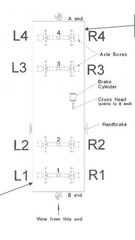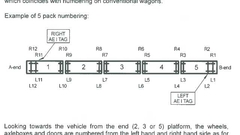![]()
![]()
![]()
Use LEFT and RIGHT arrow keys to navigate between flashcards;
Use UP and DOWN arrow keys to flip the card;
H to show hint;
A reads text to speech;
54 Cards in this Set
- Front
- Back
- 3rd side (hint)
|
Each Wagon has a unique alpha-numerical identification Number, what do each of the 4 letters in the ID mean? |
1st - Indicates Ownership. 2nd - Indicates the General Category in which the wagon belongs. 3rd - Allocated at the discretion of the Owning/Registration system and may be used to denote special operating characteristics. 4th - Indicates authorized maximum track speed of the wagon & bogie combination. The Numbers that follow are a unique Identifier within that particular class of wagon. |
|
|
|
How do you identify which wagon axle, wheel is which? How are they numbered? |

Looking from above with A end at the top, wheels are numbers L/R 4 to 1 top to bottom. |
|
|
|
How do you identify the wheel & axle numbers on articulated wagons (5,3,2 Pack)? |

Same as single plaform wagon, from B end/highest platform number. |
|
|
|
What are the 5 types of wheel tread defect? |
Skids, Scaling, Spalling, Thermal Cracks, Hollows |
|
|
|
What are the 4 main types of flange defects? |
High flange, thin flange, arisses, steep flange. |
|
|
|
What speed can draft gear normally absorb the impact of? |
7kmph. Don't make a habit of it. |
|
|
|
Where can you find operational information about any class of wagon operated by PN? |
'Wagon Data For Train Operations' Manual/Document. Found on PN Intranet. |
|
|
|
What 5 conditions can affect/cause bogie hunting? |
Wheel condition, Speed, Track Gauge, Weight/Loading, Wagon Type & Condition. |
|
|
|
Speed limits on wagons are imposed to.. |
Reduce bogie hunting. |
|
|
|
What is the difference between EX, IP & HP on the grade control valve? |
EX = 6-10 second release time. IP = 50-55 second release time. HP = 100-110 second release time. Note - We only use EX. |
|
|
|
What are the types of train inspection? |
Full Inspection (FX), General Inspection (GX), Roll By Inspections (AX, DX & RX). |
|
|
|
What inspections and tests are required for a GX or FX inspection? |
Mechanical Inspection. Continuity Test. Brake Pipe Leakage. Holding Test. |
|
|
|
What are the 4 types of cards you may find/use for wagon defects? |
Red Card (Not to go), Green Card (For Repairs), Shunter's Hazard Cards, Customer Defect Card. |
|
|
|
What is the procedure for carding a wagon? |
Fill in 2 cards and place in waybill clip on each side. Advise terminal manager or IPS to make sure info is entered in to TMS. |
|
|
|
If you need info on operating restrictions for defects what would you consult? |
Wagon Pocket Field Guide. |
|
|
|
Where should a Shunter's Hazard Card be placed? |
On the defective equipment where possible. (Handrails, handbrakes, lifting rods etc). |
|
|
|
What colour are the 3 copies of a Train Inspection Certificate and where should each copy be kept? |
White - To remain with train until destination. Yellow - To be kept by original inspector/driver & filed. Pink - Remains in TIC book. |
|
|
|
A TIC must not be issued unless which 3 criteria are met? |
1. Wagons have passed an FX or GX Inspection. 2. Last 3 Vehicles have passed a holding test. 3. Train has passed a continuity & leakage. |
|
|
|
How long is a pre-test certificate valid for after the inspection time? |
24 hours. |
|
|
|
How many Train Inspection certificates can a train depart with? |
At least 1. Up to 3. |
|
|
|
How long does a holding test remain valid? |
Until train has reached it's destination. Unless the train remains stationary for 24 hours or more with no braoe pipe pressure. |
|
|
|
How long does a holding test remain valid? |
Until train has reached it's destination. Unless the train remains stationary for 24 hours or more with no brake pipe pressure. |
|
|
|
What are the steps to a GX inspection? |
1. Leakage. 2. Drain Brake Pipe. 3. Mechanical Inspection. (One side). 4. Holding Test. (Check at rear). 5. Release Brakes. 6. Mechanical Inspection (Other Side). 7. Full Continuity. 8. Train Inspection Certificate. |
|
|
|
What are some of the Major Components to be checked during a GX (mechanical) inspection? |
Brake Pipe Hoses & Cocks, Auto Couplers & Draft Gear, Knuckles, Container Doors & Twist Locks, Brake Blocks, Brake Pistons, Brake Rigging, Load Comps, Grade Control, Wheel Tread, Wheel Flange, Visually Obvious Bearing Defects, Side Bearer Clearance, Bogie Springs, Wagon Body, Steps & Handrails, Handbrakes, Shunting Hazards. |
|
|
|
What are some common types of wagons in use by PN Intermodal? |
Flat, Skeletal, Louvered Van, Slab Steel Wagon or Tilt Wagon, Container Well Wagon, Well Wagon, Fridge Van, Curatin Side, Open Wagon & Passenger. |
|
|
|
How can you tell if a wagon is articulated based off TMS? |
Length. Note - If the second letter of the Wagon ID is 'R' it is most likely an articulated wagon. |
|
|
|
What does it mean when a wagon has a black or white square near the ID plate? |
Load Compensating Equipment is fitted. |
|
|
|
What does it mean if a wagon has a black triangle or diamond on/near the ID plate? |
Fixed choke exhaust on wagon. Triangle = 40 seconds, diamond = 30 seconds. Note - Circle is grade control equipment. |
|
|
|
What can be found on the Wagon ID plate? |
Wagon Number, Symbols (square, triangle etc.), Wagon Tare, Wagon Capacity, Length, Maximum Gross load, Loading Configuration. |
|
|
|
The A end of a 5 pack wagon is what what platform number? |
1. |
|
|
|
What types of bogies are used on PN wagons? |
1, 2 or 3 piece. |
|
|
|
What type of bogie doesn't have friction wedges and why? |
1 piece. Wedges are fitted between the bolster and side frames, they create friction to dampen wagon movement. |
|
|
|
If a wagon sideframe is cracked or bent what should be done? |
Red card. |
|
|
|
If a wagon sideframe or bolster is cracked or bent what should be done? |
Red card. |
|
|
|
What is the bolster? |
Connects the 2 side frames and keeps them the correct distant apart, supports the weight if wagon & loading. Bolster contains centre plate (queen) and side bearers. |
|
|
|
What is the bolster? |
Connects the 2 side frames and keeps them the correct distant apart, supports the weight if wagon & loading. Bolster contains centre plate (queen) and side bearers. |
|
|
|
What is the difference between Bolster (Secondary) Springs & Primary Springs? |
Bolster - in the centre of the sideframe and act on the bolster, 2 & 3 piece bogies. Primary - sit next to the axle box, 1 & 2 piece bogies. |
|
|
|
What is brake rigging? |
A system of rods, levers & beams that link the brake cylinder to the brake blocks. |
|
|
|
!!! What are some ways you could tell the difference between a 50t and 70t bogie? |
50t - 5 springs in nest. Brake Rod under bolster. 9R or 5×10 Bearings. 70t - 7 springs in nest. Brake rod through bolster. 18R or 6×11 Bearings. |
|
|
|
Where would you normally find the brake cylinder on a wagon? |
Normally mounted to the wagon body on either side. Some lesser used wagons it can be found on or under the bogie(s). |
|
|
|
R clips, split pins & linch pins are not permitted below what height? |
Below the axle centre line. |
|
|
|
What is the biggest indicator a wagon has been bogie hunting? |
Bolster gib and sideframe gib faces will have excessive wear and appear shiny. |
|
|
|
What other components should be checked if a wagon has been bogie hunting? |
Sidebearers, friction wedges, twistlocks, centreplate, bearing adaptor, wheel (sharp flanges & hollows), bogie springs. |
|
|
|
What are the main components of a wagons draw gear? |
Coupler Shank, Wear Plate, Yoke, Draft Pocket, Coupler Head, King Pin, Knuckle, Locking Block, Lock Lifter, Levers. |

|
|
|
All wagon components must be at least what distance above the rail head? |
80mm. |
|
|
|
What are the piston travel lengths for non-relayed and relayed wagons? |
Non-Relayed - 150 to 200mm. Relayed - 100 to 150mm. |
|
|
|
What are the piston travel lengths for non-relayed and relayed wagons? |
Non-Relayed - 150 to 200mm. Relayed - 100 to 150mm. |
|
|
|
What should be checked in regards to Brake Pipe hoses and end cocks? |
Cock is on outside of pipe and correctly alligned. Hose and coupling heads are free of cracks, leaks or worn points. |
|
|
|
When should the load compensator be moved to the loaded position? |
The payload is equal to or greater than 20 tonnes or the figure shown inside the circle on the data panel. |
|
|
|
If a load compensator was jammed in the loaded position what should be done? |
Green Card. If wagon is loaded no further action required, of wagon is empty the air brake equipment must be isolated on that wagon. |
|
|
|
What must be done if a mechanical slack adjuster is defective? |
Green card and isolate air brake equipment. |
|
|
|
What action should you take if a wagon's brake cylinder piston travel is exceeding or under allowable limits? |
Green Card, wagon not to be considered in braking calculations. Roll test if travel is short to ensure brakes aren't jammed or sticking. |
|
|
|
What should be looked at in particular in regards to brake blocks on a GX inspection? |
Amount of Tread remaining is above limit. No more than 1/4 of material has broken away. No overhang. |
|
|
|
What is the condemning limit for Brake Blocks? |
Terminal - 12mm. Non-Terminal - 10mm. |
|

